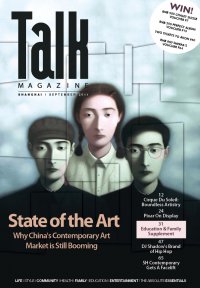China's Contemporary Art Market Boom

As both SH Contemporary and Shanghai Art Fair kick off this month, the Chinese contemporary art scene is in rude health. While art markets elsewhere have stalled due to the global economic downturn, the buzz in Shanghai amongst collectors, connoisseurs and the curious will be this year’s record-breaking spring auction season, led by a six-day US$98 million sale by Christie’s in Hong Kong. Originally the domain of international collectors, contemporary art in China is undergoing rapid development, as an increasing amount of local collectors start making their financial presence felt within the market.
In the summer of 1999, New Zealander Brendan Alborn and his girlfriend visited a small gallery in Shanghai’s Fuxing Park to buy a painting for his birthday. On display were several pieces by artist Zeng Fanzhi – Alborn’s roommate had purchased one of his works in Beijing several years earlier and he was eager to acquire one for himself. The couple decided to buy a print of Zeng’s Mask series for about US$500, instead of fronting US$3,500 for an original – a mistake they regret to this day.
“We didn't actually realise Zeng Fanzhi's paintings had appreciated in value until a friend had their painting valued for insurance,” says Alborn. “I just about fell off my chair when I googled Zeng and saw in 2008 he had broken the world record for a piece of contemporary Asian art at an auction in Hong Kong for ÚS$9.7 million.” Today, originals from the Mask series fetch prices at auction from hundreds of thousands to millions of dollars; Alborn’s print is currently valued at a meagre US$12,000. In the wild world of Chinese art, similar stories of quick fortune or missed opportunities abound.
 Paralleling the economic development of the country, over the past 20 years China’s contemporary art scene has exploded in global stature, artistic respect and headline-grabbing auction prices. In China, contemporary art is usually defined as anything created after 1979 that, in the words of art critic Li Feng, “is somewhat original, avant-garde and rejects established norms”. While paintings are currently the most popular medium, it also includes photography, video, multimedia, installation and performance art.
Paralleling the economic development of the country, over the past 20 years China’s contemporary art scene has exploded in global stature, artistic respect and headline-grabbing auction prices. In China, contemporary art is usually defined as anything created after 1979 that, in the words of art critic Li Feng, “is somewhat original, avant-garde and rejects established norms”. While paintings are currently the most popular medium, it also includes photography, video, multimedia, installation and performance art.
According to Walter Junger, owner of Galeries Junger in Shanghai and Berlin, after many Chinese art schools shifted several decades ago from classical approaches to a more free-thinking spirit, growth was inevitable. “It was just a question of time until the world had to take notice,” says Junger. “In China a lot of things go by quantity, but within that there is still exceptional quality – and now the world is taking notice with a vengeance. It’s a phenomenon that had to happen.”
As Leslie Kuo, director of Shanghai’s Leo Gallery, explains, “The market for contemporary Chinese art was forged by foreign collectors and became an international sensation roughly 15 years ago.” As a result, many of the best collections of contemporary art are overseas in private collections or museums, as a lack of knowledge and appreciation for contemporary art in Mainland China saw most Chinese miss out on early opportunities in the market.


